Table of Contents
Aventurine, revered for its shimmering appearance and known as the stone of opportunity, is treasured for its association with luck, prosperity, and abundance. Its sparkling hues, often green but also found in various colors, embody energies that promote optimism, growth, and vitality. Aventurine’s harmonizing properties and gentle vibrations make it a favored choice for those seeking positivity and a renewed sense of purpose
Color
Aventurine typically exhibits a greenish hue, often with specks or sparkles caused by inclusions of mineral deposits such as fuchsite or hematite. Its color ranges from light green to a deeper, richer green, sometimes displaying a translucent quality that allows light to reflect and create a shimmering effect. Aventurine can also occur in various colors beyond its classic green variety. While green aventurine is the most common, it can also be found in shades of blue, orange, brown, yellow, and sometimes even gray or reddish tones. Each color variation may arise due to different mineral inclusions or impurities within the stone. Blue aventurine, for instance, often contains inclusions of dumortierite, while peach or orange aventurine may have hematite or goethite inclusions. These color variations offer a diverse range of options for those drawn to aventurine’s properties and aesthetics.
Origins
Aventurine is found in various parts of the world, occurring in different geological settings. It’s commonly discovered in regions with quartz deposits, often associated with areas where there’s a presence of minerals like fuchsite, hematite, or mica. Some notable locations where aventurine is sourced include India, Brazil, Russia, Austria, China, and Tanzania. These diverse regions have geological formations that facilitate the formation of aventurine, often within quartz-rich environments or areas containing specific mineral inclusions that give aventurine its distinct appearance.
History
Aventurine is found in various parts of the world, occurring in different geological settings. It’s commonly discovered in regions with quartz deposits, often associated with areas where there’s a presence of minerals like fuchsite, hematite, or mica. Some notable locations where aventurine is sourced include India, Brazil, Russia, Austria, China, and Tanzania. These diverse regions have geological formations that facilitate the formation of aventurine, often within quartz-rich environments or areas containing specific mineral inclusions that give aventurine its distinct appearance.
Spiritual Aspects
- Abundance: “the stone of prosperity” It’s believed to attract opportunities, prosperity, good luck and abundance into one’s life.
- Manifestation: boost creativity and enhance one’s ability to manifest their desires.
- Positive Energy: Some associate aventurine with positive energy, dispelling negativity and encouraging a brighter outlook.
Emotional Aspects
- Harmony: bring harmony and balance, particularly in emotional matters. It’s believed to calm and soothe turbulent emotions, promoting a sense of inner peace.
- Emotional Healing: Aventurine is associated with the heart chakra and is believed to facilitate emotional healing. It’s thought to help release emotional blockages, past traumas, and negative patterns, fostering a more open-hearted approach to life.
- Compassion: helps open the heart chakra and promote feelings of compassion, love, and empathy.
- Creativity: enhances creativity and motivation, assists with decision-making. It’s thought to stimulate innovative ideas while encouraging perseverance in pursuing goals.
- Decision Making: Aventurine is believed to assist in decision-making by providing clarity and a sense of confidence in one’s choices.
Physical Aspects
- Blood pressure: balancing blood pressure and lowering cholesterol encourages regeneration of the heart.
- Metabolism: helps stimulate and increase metabolism, which is important for losing or gaining weight.
- Anti-Inflammatory: helps with allergies, acne, migraines, and joint pain or arthritis.
- Respiratory: helps heal the lungs and sinuses.
- Urogenital systems: Aventurine stone is good for problems in the urogenital system.
- Thymus gland: help balance the hormonal system, offering support for hormonal imbalances or issues related to the endocrine glands.
- Nervous system: improve functionality, calm the nervous system
- Skin Health: Some traditions suggest that aventurine can aid in skin conditions, contributing to clearer skin and alleviating certain irritations.
- EMF Protection: Shielding against geopathic stress and electromagnetic smog, such as that emitted by cell phone towers, cell phones, computers, TVs, and similar devices, while absorbing and providing protection.
Types of Aventurine
Green Aventurine is known for its vibrant green color. It is often referred to as a “stone of opportunity” and is thought to bring good luck and prosperity. Green aventurine is also believed to have a calming effect, which can help reduce stress and anxiety. In addition to its metaphysical properties, green aventurine is also used in jewelry and other decorative items due to its attractive appearance. It is often cut into beads, pendants, and other small shapes that can be used in jewelry making. balance the heart chakra and stimulate physical healing. Blocks the electromagnetic radiation emitted by computers, televisions, and other electronic devices. calms motion sickness and eliminates unfavorable thoughts and emotions. It promotes happiness and emotional peace. used to support eyesight as well. Good for meditation, allows one to connect with and communicate with beings from other worlds. It fosters spiritual development and advances knowledge of the
cosmos and one’s position within it. 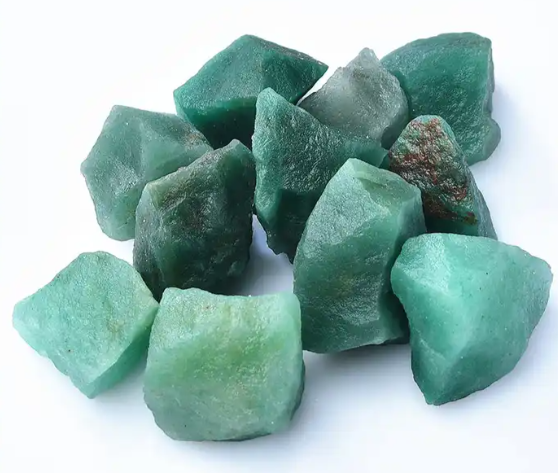
Blue aventurine has a blue color, ranging from light to dark blue. It is believed to have calming and soothing properties and is often used to reduce stress and anxiety. Blue aventurine is also associated with communication and self-expression, making it a popular choice for those looking to improve their communication skills and express themselves more effectively.
Activate psychic powers; recommended for use under the pillow; aids in the treatment of addictions such as alcohol, smoking, and others.Balances the throat chakra and improves communication, allowing you to speak up and be authentic.helps in removing stagnant old thoughts and energies and growing spiritually.
In addition to its metaphysical properties, blue aventurine is also used in jewelry making, home décor, and feng shui. It is often cut into beads, pendants, and other small shapes that can be used in jewelry making, and it is also used to make statues and other decorative items. 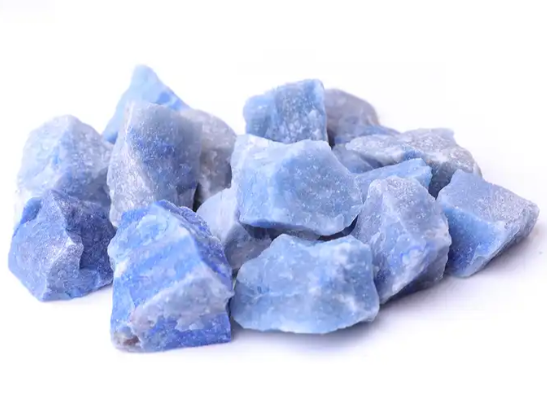
Yellow aventurine has a yellow color, ranging from light to dark yellow. It is often referred to as a “stone of manifestation” and is believed to bring good luck and prosperity as well as encourage creativity and personal growth. It is believed to be a stone of happiness and optimism and is often used to bring joy and positivity into one’s life. Yellow aventurine is also associated with creativity, making it a popular choice for artists, writers, and other creative individuals.Balance the solar plexus chakra and improve self-confidence.
In addition to its metaphysical properties, yellow aventurine is also used in jewelry making as well as in home décor. It is often cut into beads, pendants, and other small shapes that can be used in jewelry making, and it is also used to make statues and other decorative items. 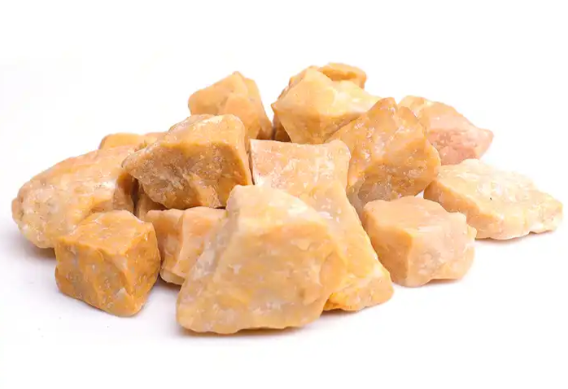
Red aventurine has a red color, ranging from light to dark red. It is often referred to as a “stone of motivation” and is believed to stimulate energy and motivation as well as encourage confidence and courage. Red aventurine has a grounding effect, which can help reduce stress and anxiety.Red aventurine is also associated with passion and courage, making it a popular choice for those looking to increase their confidence and drive.
Balance the root chakra and stimulate physical energy and vitality. 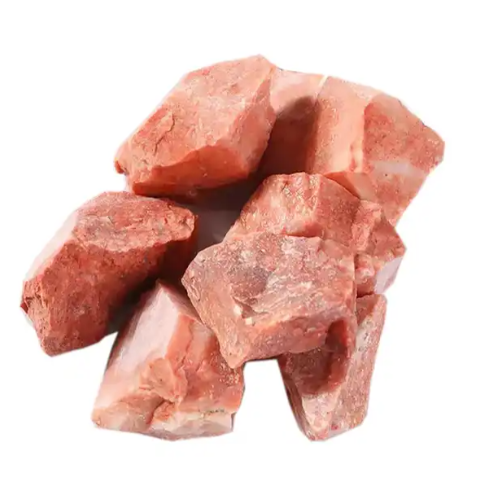
Orange aventurine has an orange color, ranging from light to dark orange. It is associated with energy, enthusiasm, creativity, confidence, and personal power and is often used to promote self-esteem and a positive outlook on life. Orange aventurine is also believed to have a grounding effect, helping to calm the emotions and reduce stress, stimulate motivation, and bring a sense of joy and happiness.
Have a positive effect on the sacral chakra, which is associated with sexuality, creativity, and personal power.
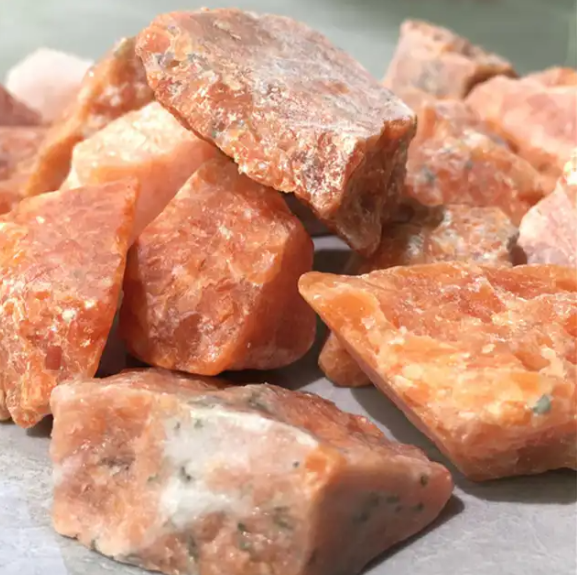
Pink aventurine has a pink to pale pink color. It is often referred to as a “stone of love” and is believed to promote feelings of love, compassion, and tenderness. Pink aventurine has a calming effect, which can help reduce stress and anxiety.
Pink aventurine is also thought to enhance feelings of self-love and self-acceptance, making it a popular choice for those looking to improve their self-esteem and emotional well-being.
Balance the heart chakra and promote emotional healing.
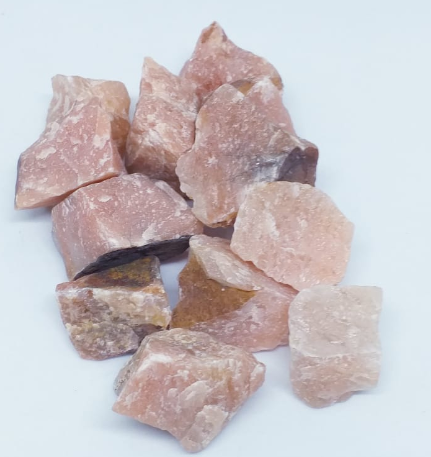
Purple aventurine has a purple color, ranging from light to dark purple. It is associated with intuition, wisdom, spiritual awareness, and psychic abilities and is often used to stimulate the third eye and crown chakras. Purple aventurine enhances one’s connection to the spiritual realm and promotes spiritual growth.
It is associated with spiritual growth, intuition, and wisdom and is often used to enhance spiritual awareness and promote inner peace. Purple aventurine is also believed to have a positive effect on the third eye chakra, which is associated with
Have a positive effect on the third eye and crown chakras, thus increasing intuition and stimulating spiritual growth and psychic abilities.
